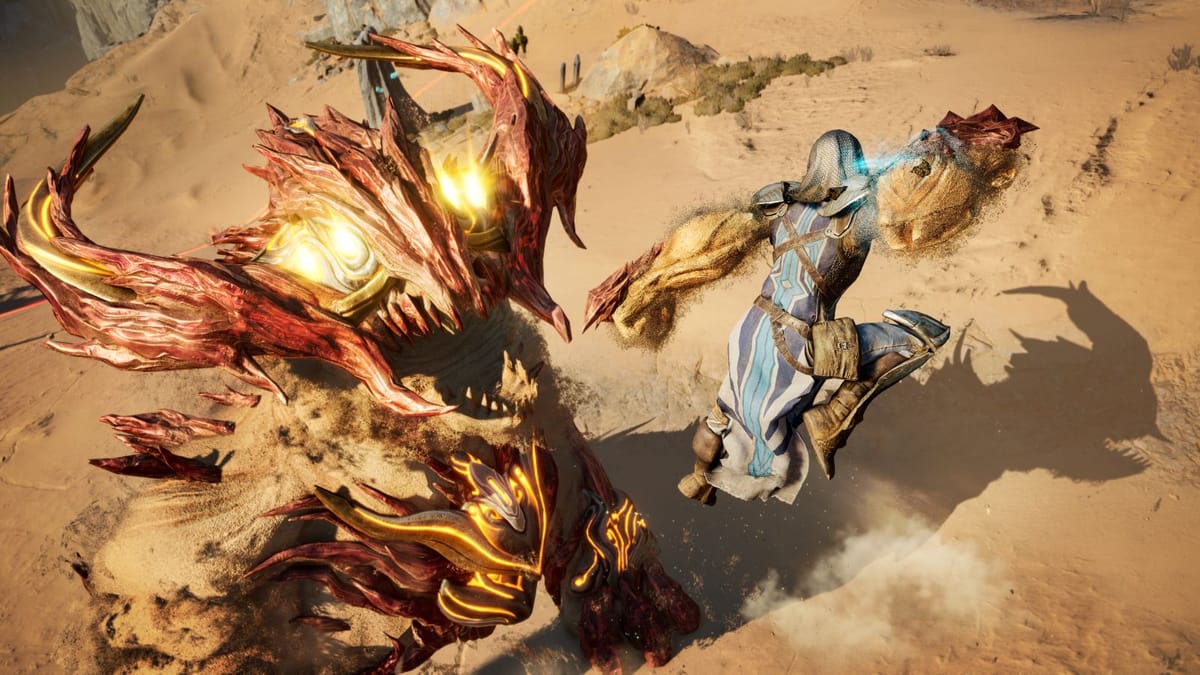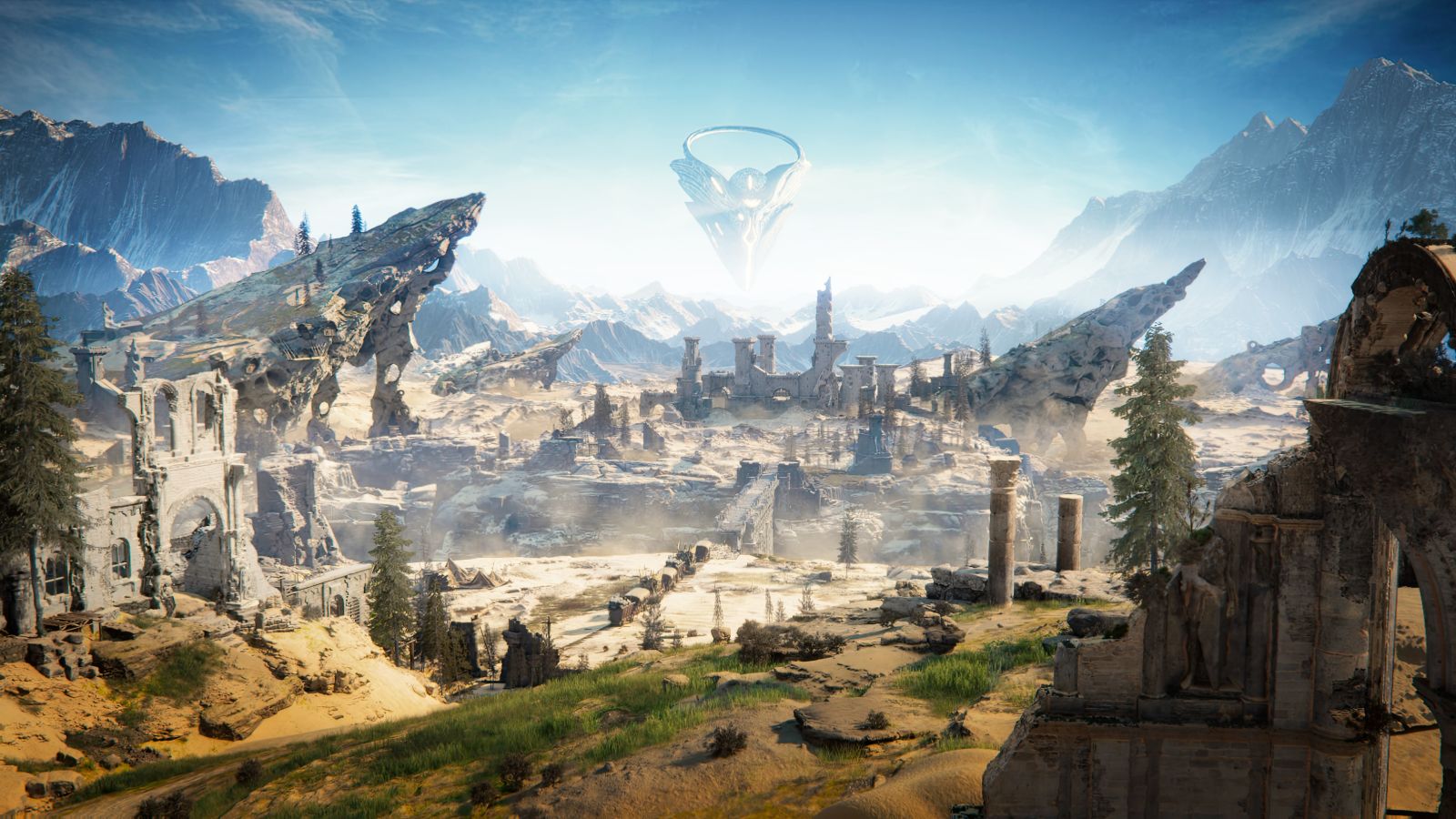
Honestly, in a year packed with so many phenomenal titles, who needs much else? After watching a lot of games launch, just in the first half mind you, we almost don’t need more. That said, the second half is packed with just as much, and I wouldn’t blame you if you missed this one, Atlas Fallen. I mean, the name isn’t that interesting; it almost sounds like it was created by AI. In a year with more, this certainly provides, filling a niche I didn’t know still existed. That being, the AA game we used to often see in the PS2 era. More is great, but it isn’t always best, so let’s talk more about Atlas Fallen.
Everything begins with a short tutorial, and you’re going to be lost as to what’s going on in it. After all, I’m a blue Avatar-looking dude jumping from sandy rock to sandy rock, confronting whatever I find. From there it all seems to be a dream, with your character awakening and the ever so wonderful customization that comes with it. It’s pretty good for a smaller game, even if somewhat limited.
Once we’re through all the start-up, your character (known as an “Unnamed”), wants to urge the caravan of peasant class workers to fight back against the oppressors. You’re trapped in a sandstorm, and the way the troop is pushing onwards isn’t feasible. After the confrontation with Morrath, the leader of the camp, you’re sent out into the wilds to retrieve something stolen from him as a punishment… and that’s if you even live through your assignment.
Traversing through the windy desert you hear a voice; and it’s a gauntlet that calls to you (and keeps talking to you for that matter). Why, I’m not sure, but after donning it and beating up wraiths (the sandy beasts that inhabit this realm), you’re back with the stolen item in hand, only for it to be taken from you by Morrath. Cue another trip to find him and get the gauntlet back, falling down a hole, and soon sand-surfing to the open world, and here you are, where the true game starts.
What follows is a bland story that thankfully gets stronger in its second half. At first I’m not sure why I’m here, or even why I care, and a lot of that is due to the characters. The Unnamed is somewhat of a blank canvas, and not in a good way. Honestly, most of the supporting cast have the personality of cardboard; they say their piece without much emotion. The most you get comes towards the end when certain story revelations happen, and it takes an actual tragedy to pull it out of them. Also, can we just stop with the talking clothing/accessories in games already? That’s proven to be a bad move so far this year. Together, it’s all disappointing, because the story has the opportunity to be very engrossing, but it struggles.
That makes for a slog of a first half, and it wasn’t until I made it to a certain juncture that I was actually interested in what was happening. There isn’t necessarily a specific plot point, but I think overall once you start to understand what’s happening here, i.e. why a gauntlet is talking, why the Queen and Thelos are tyrants, why it’s up to you to be the savior, things start to flow better. The drip feed doesn’t work as well for this one.
There are a great many side quests in Atlas Fallen. Many of them fetch quests, they often involve you talking to one person, sand surfing to the other edge of the map, beating up a beastie that needs a beating, collecting a MacGuffin of some kind, and sand surfing your way back. The good news is that, while the side quests might not be memorable, the rewards certainly are. Nearly every one of them either rewards you with a rare crafting material for power upgrades, or an entirely new Essence Stone (more on those below). Like the main story, these actually improve in later missions, with a few of them turning into downright mysteries – stick with these, they are rewarding.
Even more rewarding is the actual gameplay and exploration ahead of you. The world of Atlas Fallen is pretty vast, more than you’d expect at first glance. There are several areas you’ll go to – unfortunately the open world isn’t seamless – but it still feels just fine in terms of the world building and your character’s growth from zero to hero. Each place you visit can be pretty dead in terms of feeling lived in, but that gets explained; Thelos has been sucking the land dry throughout his reign, so it’s a believable plot point. It’s a beautiful world worth exploring, with plenty of rabbit trails to go down.
Playing Atlas Fallen takes you down a bit of a different path, in that I’m reminded a lot of Darksiders with maybe a little bit of Hulk’s Ultimate Destruction thrown in, at least as movement is concerned. You certainly feel powerful because of the gauntlet, being able to leap to astounding heights and air dash across canyons.
All of that isn’t taking into account the sand-surfing, probably the thing you’ve seen most in the trailers. It’s so much fun to do, sliding around the world as smooth as you’d think. The only place it gets a little hairy is when you’re trying to maneuver with precision, and it’s kind of like steering a sled. You aren’t going to do much combat in this mode, so it works for that. Though, it is a bit annoying with how it works; I get that you can only surf on sand, but occasionally you’ll have sandy places with rocks and I’ll try to sprint, only to be interrupted by a split second surf, which cancels my run and I have to hit the button again. I like the feature, but making the initiation of the mechanic a bit more broad would be helpful.
The combat is a ton of fun, and truly, it just works. You can summon a sand-crafted ax, whip, or fists (like I said, bit o’ Hulk in here), and pound away at things three to four times your size. The reason this isn’t just another hack and slash/punch game comes in the form of the Momentum gauge. Below your health is a meter that fills as you attack, and the higher it goes the more damage you do. That is countered though by you also taking more damage, so you have to make decisions based around it.
This is compounded with your Essence Stones, otherwise known as cooldown and passive abilities. We’ll talk more about them below with builds, but they can be as simple as a boost in damage or defense, all the way into summoning tornados to do area of effect damage for a predetermined amount of time. These unlock the further your Momentum builds. If you take hits or unleash your Momentum via a “Shatter” ultimate attack, that will drain the meter all the way back down. Do you just continue to reap the rewards of higher damage and all of your abilities? Or is it worth the risk of taking a critical hit that makes you restart, meaning shattering and going back to square one to save health is the best option? It’s a fantastic system, and one that deserves your investing into it.
Your Essence Stones are the secret sauce of Atlas Fallen, and frankly why you might even see fit to play it more than once. Every time you obtain a new one, there’s a chance it’ll be able to be fused with one you have in your collection. These grant new powers, change the way combat flows, and can dramatically alter your power level. For example, you might have one build that revolves around heavy damage and little defensive power, but fusing it with a different Essence suddenly changes the whole shooting match into a crowd control powerhouse, able to freeze an enemy in its tracks. Every Essence Stone can also be upgraded using the crafting materials that dot the landscape, increasing their associated powers, be they defensive, offensive, or utilitarian. If you are the kind that likes to switch things up, you can also set three presets and rotate through them as you see fit.
Throughout your adventure you’ll obtain armor – quite a few of them in fact. Each has multiple upgrades, improving their attack, defense, and other associated stats. Unlocking the final one also provides a special power of some kind, making each one unique. You can’t change them during combat, so you’ll have to plan ahead for the beasts you’ll face (more on that in a moment), but each upgrade also grants a Perk point. These perk points unlock more than a dozen special improvements for your character. One in particular has a direct impact on the Essence Stone upgrades I just mentioned, as stacking all of the same color in one of your three attack tiers powers it up with a bit more oomph. Best of all, if you don’t like the look of the armor you just picked up, but like the stats, there’s a full transmogrification system that’ll let you simply make it look like something else. Hooray choices!
When you start Atlas Fallen, it’s very easy to slip into the button mashing mode, banging away at enemies until they drop and taking a ton of damage in the process. Where the game clicks is when you take a beat and learn how to time your blocks. Blocking is a pretty cool feature in Atlas Fallen after all, with the ability to freeze your enemy in place in one or three parries (depending on the type). There are Essence Stones that will increase the window of your block, or even block for you automatically, albeit with a cooldown, but mastery of this system can be a huge boon to your gameplay. Bosses that would feed you your face otherwise become easy, or at least easier, when you can time your block to absorb their incoming attacks.
The bestiary, in my opinion, might be the high point of the game. Not often do you enter a game and see something as unique as the creatures Atlas Fallen has for you to fight. They aren’t necessarily different from everything else in terms of design, with crabs, scorpions, and such, but they all are alive in their own way. A lot of that is due just to fantastic construction, but also the way you fight them, with each having specific parts to wail away at until they fade into dust. It’s a challenge figuring out how to best assault them, with each having different patterns to memorize. There’s a bit of Soulsy-ness to it, and I like that. Oh, and the Conjurer can go die in a fire.
The specific parts on a creature aren’t just for show, either. Once you’ve mastered the timing on the various monsters you encounter, you’ll be able to start to farm them for rare crafting materials. The various bosses will often have a specific part that is gold instead of red. Breaking these parts will result in a loot drop in addition to the loot they’d normally deposit on the ground upon their demise.
Ron, our Editor-in-Chief, and I played for a while, and there was no tether either; we ran around doing different things as we pleased. The big activities, like story missions, require you both to be together, but everything else is free-form. Beyond that, beating up beasties is a ton of fun to do side by side, and the bosses seemed easier to take out with two heads rather than one.
[Co-op vid]
To ensure there’s proper power leveling in multiplayer, the joining player’s power is adjusted to match the progress of the hosting player. You get to keep your Essence Stones, acquired armors, and perks, so you might have some additional edge, but your stats are bumped up or down accordingly. What was surprising, however, is that the game isn’t actually built around co-op, but simply supports it. This game is built as a single-player experience, but you can bring a friend if you wish.
Before we get out of here, we have to talk a little bit about the technical aspects of Atlas Fallen. While the world is pretty and decently varied, the character models are very “last-gen” looking. They aren’t the focal point of the game, so that’s good, but it’s definitely noticeable when you head into cities and encampments where a lot of them are. They’re serviceable, and that’s the best way of putting it.
I also encountered a lot of invisible edges when running around. It wasn’t often, but occasionally you’ll think a lip of something you’re walking over or climbing up should simply allow for you to move past it, but it instead stops you dead in your tracks. This mainly is annoying when you’re platforming, with certain ledges getting in your way rather than being an intelligent obstacle.
Lastly, there were a couple of bugs I ran into. The performance mode actually feels decently smooth, with only a few choppy moments. But, I had two instances where the game froze in a boss fight, prompting a restart. Combine that with my button presses not completely registering in the final confrontation (sometimes it worked, sometimes it didn’t), forcing me to die and hope it worked again after I started over. It did, but shouldn’t have been an issue in the first place. Nothing is over the top, but technical issues are still noticeable.
Atlas Fallen
Good
I wouldn’t go into Atlas Fallen looking for a great story, but if you’re looking for an interesting world to explore, this might fit the bill. The gameplay is a lot of fun, with foes worth your time to engage, and a fantastic customization system to battle your way. Atlas Fallen fills that old “AA THQ” hole, perfect for what it is.
Pros
- Awesome traversal and melee components
- Momentum system
- Vast, appealing world
- Phenomenal enemy design
Cons
- Bland narrative
- Dull characters
- Random glitches


